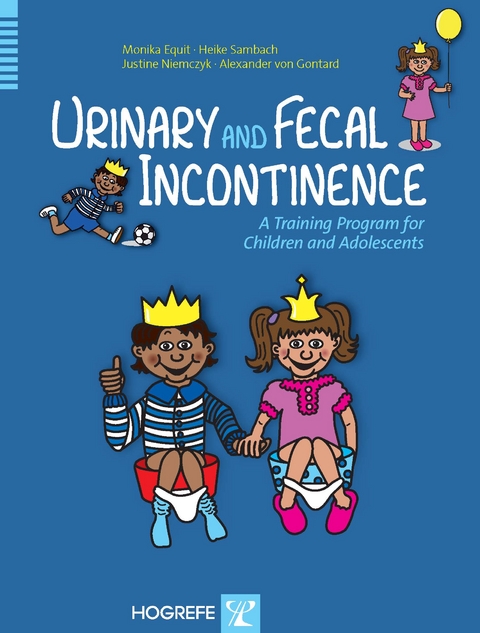
Urinary and Fecal Incontinence
Hogrefe Publishing
978-0-88937-460-7 (ISBN)
Elimination disorders (such as bed-wetting or soiling) are common in childhood. This manual presents a new and effective training program for children and adolescents with nocturnal enuresis, daytime urinary incontinence, fecal incontinence, or a combination of these forms, who do not respond to standard measures. After discussing the different types of incontinence and comorbid psychological disorders, the expert team of authors (a psychotherapist, a pediatric nurse, a psychologist, and a psychiatrist) describe a 7-9 session program of bladder and bowel training, primarily for use in groups but which can also be used with individuals. The training encompasses psychoeducation, operant reinforcement, emotion regulation, and relaxation techniques - all presented in a "child-friendly", playful manner. The manual itself is accompanied by a wealth of colorful, attractive, printable worksheets and other educational materials suitable for youngsters, which cover topics such as healthy drinking and eating habits, stress and emotion regulation, body perception, toilet training, and relaxation techniques.This manual is a superb resource for pediatricians, specialists in child and adolescent psychiatry, psychologists, nurses, urotherapists, and all other professionals looking for well-founded, hands-on guidance on treating children and adolescents with incontinence.
Monika Equit; PhD; Psychological psychotherapist and researcher, Department of Child and Adolescent Psychiatry, Saarland University Hospital, Saarbruecken, Germany Heike Sambach; -; Pediatric nurse and urotherapist, specialist outpatient clinic for elimination disorders, Department of Child and Adolescent Psychiatry, Saarland University Hospital, Saarbruecken, Germany Justine Niemczyk; -; Clinical psychologist, specialist outpatient clinic for elimination disorders, Department of Child and Adolescent Psychiatry, Saarland University Hospital, Saarbruecken, Germany Alexander von Gontard; MD, Professor; Board certified child and adolescent psychiatrist, pediatrician, psychotherapist; Chair and head of the Department of Child and Adolescent Psychiatry , Saarland University Hospital, Saarbruecken, Germany
Preface Introduction 1 Theoretical Background Chapter 1: Incontinence During Childhood and Adolescence 1.1 Nocturnal Enuresis 1.1.1 Definition and Classification 1.1.2 Subtypes . 1.1.3 Prevalence 1.1.4 Differential Diagnoses and Comorbid Disorders 1.1.5 Etiology 1.2 Daytime Urinary Incontinence 1.2.1 Definition and Classification 1.2.2 Subtypes 1.2.3 Prevalence 1.2.4 Differential Diagnoses and Comorbid Disorders 1.2.5 Comorbid Psychological Disorders 1.2.6 Etiology 1.3 Fecal Incontinence (Encopresis) 1.3.1 Definition and Classification 1.3.2 Subtypes 1.3.3 Prevalence 1.3.4 Differential Diagnoses and Comorbid Disorders 1.3.5 Etiology Chapter 2: Assessment 2.1 Standard Diagnostic Assessment 2.1.1 History 2.1.2 Development and Family History 2.1.3 The 48-Hour Bladder Diary 2.1.4 Physical Examination 2.1.5 Sonography/Urinalysis 2.2 Extended Assessment for Complex Elimination Disorders 2.2.1 Uroflowmetry 2.2.2 Bacteriology 2.2.3 Further Pediatric and Urologic Diagnostic Steps 2.3 Psychological Tests Chapter 3: Treatment of Incontinence 3.1 General Treatment Principles 3.2 Treatment of Fecal Incontinence 3.3 Treatment of Daytime Urinary Incontinence 3.3.1 Urge Incontinence 3.3.2 Voiding Postponement 3.3.3 Dysfunctional Voiding 3.4 Treatment of Nocturnal Enuresis 3.5 Urotherapy as a Treatment for Complex Elimination Disorders 3.5.1 Definition 3.5.2 Scientific Evidence 2 Therapy Manual Chapter 4: Description and Structure of the Manual 33 4.1 Development of the Manual 4.2 Formal Aspects of the Training 4.3 Contents of the Sessions 4.4 Including the Parents 4.5 Application as Individual Training 4.6 Application to Adolescents Chapter 5: How to Conduct the Sessions 5.1 Session 1: Introduction, Defining Problems and Goals 5.2 Session 2: Anatomy and Physiology 5.3 Session 3: Pathophysiology of Wetting and Coping With Stress 5.4 Session 4: Drinking 5.5 Session 5: Going to the Toilet, Hygiene, and Constipation 5.6 Session 6: Emotions, Body and Bladder Perception 5.7 Session 7: Knowledge Check, Goal Analysis, Outlook 5.8 Bowel Training Session 1: Problem and Goal Analysis, Pathophysiology of Fecal Incontinence 5.9 Bowel Training Session 2: Diet and Exercise Chapter 6: Evaluation of the Treatment 6.1 Sample 6.2 Method 6.3 Results 6.4 Conclusion 6.5 Final Remarks References Appendix
| Erscheint lt. Verlag | 1.8.2014 |
|---|---|
| Zusatzinfo | illustrations |
| Verlagsort | Toronto |
| Sprache | englisch |
| Maße | 210 x 277 mm |
| Gewicht | 318 g |
| Themenwelt | Geisteswissenschaften ► Psychologie |
| Medizin / Pharmazie ► Medizinische Fachgebiete ► Psychiatrie / Psychotherapie | |
| ISBN-10 | 0-88937-460-0 / 0889374600 |
| ISBN-13 | 978-0-88937-460-7 / 9780889374607 |
| Zustand | Neuware |
| Haben Sie eine Frage zum Produkt? |
aus dem Bereich


